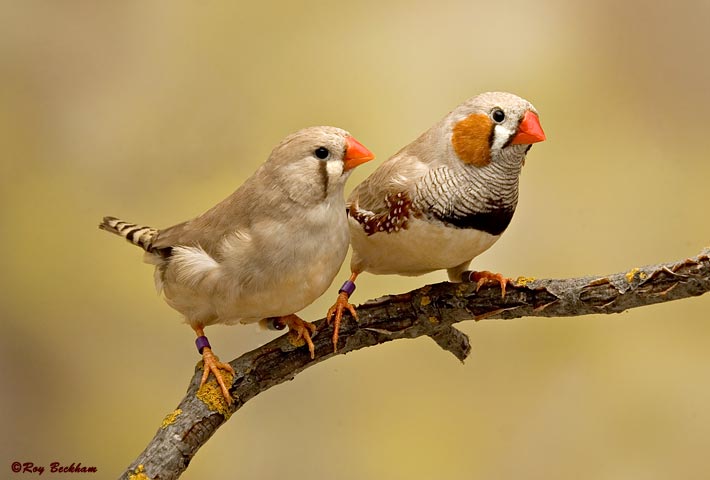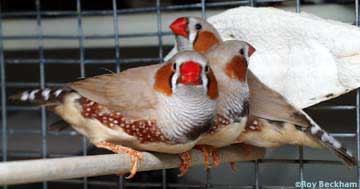




 |
|
|||||||||||||||||||||
 |
|
|
|
|
|
|
|
|
|
|||||||||||||
|
|
|
|
|
|
||||||||||||||||||
|
|
|
|
|
|
|
|
|
|
||||||||||||||
|
|
|
|
|
|
||||||||||||||||||
|
|
|
|
|
|
|
|
|
|
||||||||||||||
|
|
|
|
|
|
||||||||||||||||||
|
|
|
|
|
|
|
 |
|
|||||||||||||||
 |
 |
|
||||||||||||||||||||
|
|
|
|
||||||||||||||||||||
|
|
|
|
|
|
|
|
|
|
|
|
|
|
|
|
|
|
|
|
|
|
|
|
| Fawn Zebra Finch | ||||
 |
||||
| Fawn Zebra Finches. Male (right) and female (left) | ||||
|
Mutation Effects Male: The fawn mutation changes the normal gray and black coloring to a light brown or fawn coloring with dark brown markings. The male cheek and flank marks are nearly the same color as the normal, but are slightly diluted. Males will often have a buff colored belly and some standards consider this a fault, preferring a white underside, while other standards call for it. All markings normally black will be changed to a dark, chocolate brown. The base gray color changes to the light brown. There is some variation in the depth of that color. Female: Like the male, the base color is changed to a light brown or fawn color. Tear mark and tail markings are dark brown. The belly will be buff like the normal if not more so. Fledglings: Fawn chicks will have light colored skin in the nest compared to the dark, near black of the normals. The beak will be horn-colored. As soon as the feathers are visible, the fawn coloring can be seen. The eyes of the chicks may appear ruby red. Fawn nestling in with its Gray siblings (click to view) Identifying Splits Female: Females cannot be split for a sex linked gene. Combinations Combinations with the other sex-linked mutations requires a genetic phenomenon known as crossing over to occur before Fawn and the other mutation can be combined. Crossing over is a random occurrence so one cannot predict how long, if ever, before the combination will occur. Fawn Lightbacks can be attractive birds, but are not easily distinguished from regular Fawns except for the white belly in both sexes. Fawn CFWs are occasionally seen, but I do not find them that attractive. I think the charm in the CFW comes from the contrast of normal markings on an otherwise white bird. The diluted markings on a Fawn CFW do not have the contrast to make them appealing to me. Black Breasted Fawn (click to view) Notes Fawn birds often have a type of feathering known as buff. This is a 'fluffier' feather type and often helps with the apparent type and size of the bird. Buff feathered birds can have markings that are not as sharp or crisp looking though and with the Fawns tendency to have a really buff type of feathering, markings can suffer. The best matings may come from buff x tight feathered birds. The Fawn used to be known as 'Cinnamon', but that term is no longer used. The name Cinnamon should be applied to yellow ground birds like the Canary and Fawn to white ground birds like the Zebra. |

Fawn males
